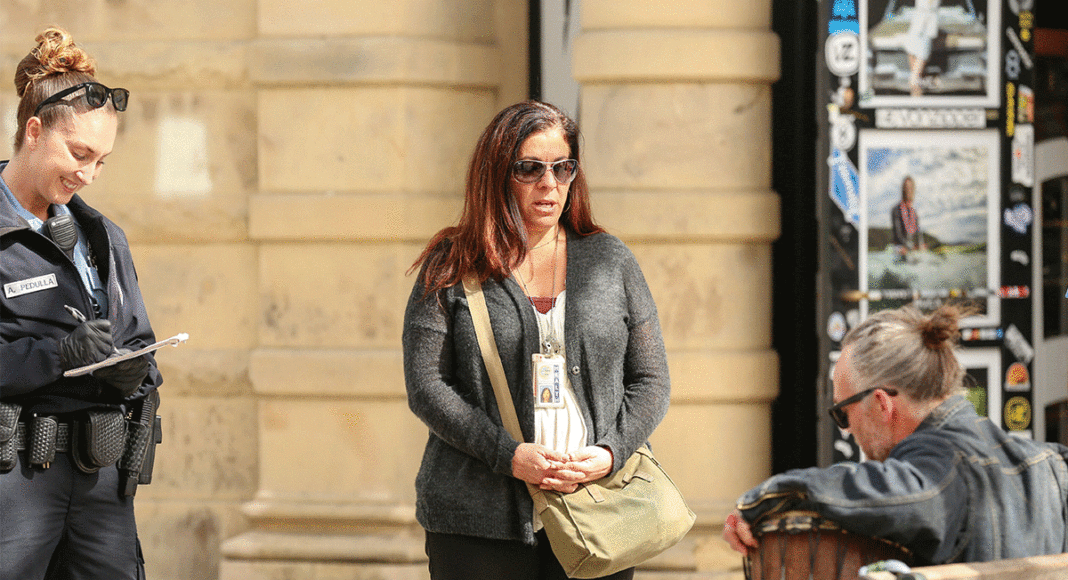[This is part one of a two-part series on veterans and public safety. Part two runs next week.]
Ingrid Trejo was at a memorial in November, reflecting on the sad death of Mitchell Horton—an acquaintance of hers and a veteran who’d been active within the vet community—when she suddenly recognized a police lieutenant, whom she knew through a mutual friend.
Trejo, the regional director for the Central Coast Veterans Resource Center (VRC), walked over to Warren Barry of the Santa Cruz Police Department (SCPD) and struck up a conversation, saying, “So I understand you give courtesy rides sometimes to residents who aren’t arrested.”
Barry told her that was correct, and Trejo wondered if officers might be able to offer veterans who they interact with on the streets a lift over to the VRC on Soquel Drive. Barry was intrigued. As the two chatted, they began working out the details of a new courtesy ride program that SCPD is unrolling this week for veterans who are homeless or struggling.
“Once we’ve confirmed their veteran status, and they are in need, we take them directly [to the center],” explains Rick Martinez, deputy chief for SCPD. “And there will be a case manager there that will sit down with them and start working on a program.”
Under the pilot program, when a veteran comes in the door, someone from the VRC will check to see if he or she has access to benefits through the Supportive Services for Veteran Families—a perk that applies to vets who haven’t been dishonorably discharged.
If they are eligible, Trejo’s crew will work to get them housed, if needed, and see what services the vet is interested in, like job training or counseling. If the veteran is ineligible, a staffer will call the Homeless Services Center to see if anyone there can help.
The Santa Cruz County Board of Supervisors launched an ambitious goal in October of 2014, when it signed onto a pledge from around the country to house all homeless vets—there were more than 300 locally at the time—by the end of 2015. County leaders extended the benchmark to the end of 2016, although there are still 92 homeless veterans in the county, Trejo says. She believes the courtesy ride program will help the VRC meet its goal.
Martinez hopes the new model proves successful and spreads to the other law enforcement agencies around the county. The basic idea is already popular.
“It’s great. It’s another example of our agencies’ efforts to do right by our veterans in our community,” says James Keeley, a veteran and advisor for the local nonprofit Holistic Veterans.
Keeley mentions that the local Veterans Court—which helps vets who are coping with drug addiction, mental health issues or other struggles—is another example of a partnership that has been helping people who’ve served.
Keeley, who was honorably discharged from the Navy in 1995, went back to school at San Jose State for recreation therapy, thanks to the GI Bill. He just received his certification, and hopes he can start working for the Department of Veteran Affairs soon.
Keeley remembers a few years ago when he hit a rough patch in his life. He found out about veteran services and began taking advantage of every one that he could. He credits those programs with helping him turn everything around.
“Many veterans, including myself, don’t identify as a veteran when they’re in crisis,” he says. “These things help vets realize they have support.”
While the focus is on vets for now, Martinez is optimistic that officers will one day be able to offer similar services to people from all walks of life suffering from mental health, addiction and homelessness. Hopefully at some point, Martinez says, with more fully funded social services, officers can “take the justice system out of it and really bring forward a system of care that actually treats the core issue.”
In recent months, tensions between mental health advocates and law enforcement have been in the spotlight after officers shot and killed mentally ill Sean Arlt, a 32-year-old who charged deputies with a large metal rake at 3:30 a.m. on Oct. 16, according to the SCPD. Officials plan to release audio and video of that event in the coming weeks.
Long, whose position is funded through Santa Cruz County’s health department, spends 40 hours a week on patrol with officers, and she worked on fine-tuning the new courtesy ride program with Trejo and Barry.
“Those who have served the country who are homeless, it’s really our job as county to provide them with the support that they need to help them out of homelessness or out of poverty or help them out of their situation,” she says. “They signed up for a career with a possibility of giving their life.”














Good stuff, every little bit helps. There are way to many in need and more needs to be done.